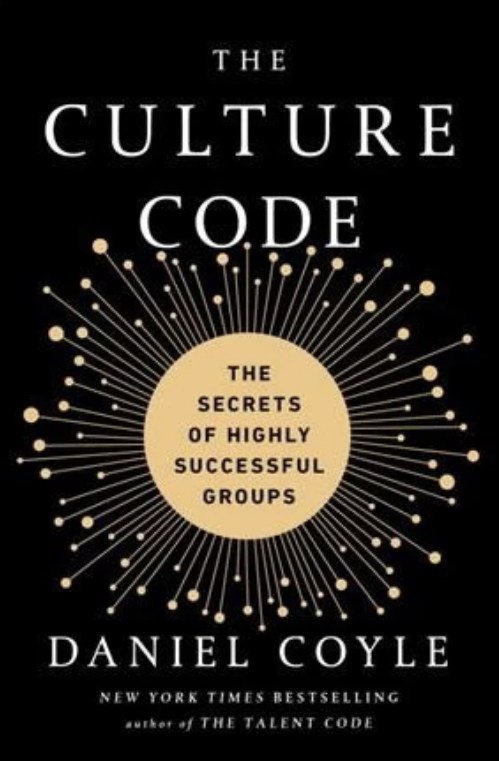Manager Reads - The Culture Code: The Secrets of Highly Successful Groups
10 Dec 2018Next up in the Manager Reads adventure is The Culture Code: The Secrets of Highly Successful Groups by Daniel Coyle.
Who recommended the book? This book was highly recommended by my team’s VP of Engineering, Michael Comperda, and selected as the next book for the Twitch Leadership Book Club. How is a book selected for the club? At the end of each meeting we carve out some time for people to recommend books and champion a particular book for the next month’s meeting. Then we coalesce on one and that’s it! We keep a running list of all recommendations that we don’t select and revisit that list during this time as well.

Judge the book by its cover, font, page quality? The hardcover version of The Culture Code sports a simple linear display of its stuff: title, a sun-looking image thing containing the subtitle, author, an award the book received, and the title of another book the author published. It’s straightforward although the spores coming from the sun thing almost touching the title and the author makes my skin tingle. Inside we’ve got thick paper and sans serif font for chapter titles but a font with serifs for the actual text.
Thoughts on the book and the big take-aways? When teams are greater than the sum of their individual parts you have a strong group culture acting as a force multiplier on that team. Don’t have strong culture or want to figure out what you’re inadvertently doing that is yielding such positive results? Coyle breaks forming a strong culture into three steps:
-
Build Safety - A sense of safety is a prerequisite to a strong culture because we need to shift our brains from worrying about danger into connection mode. Once there we’re in a state of psychological safety. It’s no surprise Google’s Project Oxygen found psychological safety to be the most important dynamic in effective teams. How do we build a sense of safety? Flood it with belonging cues – little moments of social connection – like eye contact, few interruptions, close proximity, small courtesies like thank yous, and laughter.
-
Share Vulnerability - While in our hyper-competitive world we naturally tend to avoid expressing vulnerability, Coyle aptly argues that “vulnerability doesn’t come after trust - it precedes it. Leaping into the unknown, when done alongside others, causes the solid ground of trust to materialize beneath our feet.” If we’re aiming to solve challenging problems, we have to acknowledge our weaknesses so we can focus on the task at hand instead of focusing on covering up our insecurities. Here it’s important for the leader to take charge and share their vulnerabilities by asking for feedback. This sends a clear and contagious signal that sharing vulnerability is okay.
-
Establish Purpose - From there you want a simple beacon (e.g. story, credo, principles) that focus attention and engagement on the shared goal. This isn’t something that pops out of thin air or sticks with people forever once you tell them once; you’ll need to continually evolve your beacon and constantly communicate it to your team. You might’ve seen a story about Tylenol and cyanide lacing making the rounds on social media these days as an example of how people feel Facebook is failing to take responsibility for its actions. Coyle highlights Tylenol’s credo as a 311 word document that “oriented the thinking and behavior of thousands of people as they navigated a complex landscape of choices.” Make a credo and then live by it.
Each of these three ideas gets several chapters dedicated to them: one to introduce the concept, a few to dive in and cover some real-world stories, and a final chapter that explicitly spells out things we can do to put that idea into action.
Favorite quote from the book? “Laugher is not just laughter; it’s the most fundamental sign of safety and connection.”
Elevator pitch for suggesting (or not suggesting) the book? Read this. If you’re on a team with a great culture, you’ll arm yourself with insight to understand why that team functions so well. If you’re on a team that has room for its culture to improve, you’ll be armed with tools to start improving things. Whatever state your team’s culture is in currently, it’s impacting your team’s ability to succeed. If you’re currently at 1 + 1 = 1, aim for 1 + 1 = 3. If you’re at 1 + 1 = 3, aim for 1 + 1 = 10. It’s absolutely worth the time and effort.
Notes in Evernote? This book is packed with nuggets of wisdom that can help build better teams. Feel free to review my notes on 🐘.
Most of the world’s wisdom is written down in its best books. Manager Reads is a series covering books on management and leadership, focusing on books that can improve your own leadership with the wisdom of others. Enjoyed this post and want to see more? Check out more at Manager Reads.